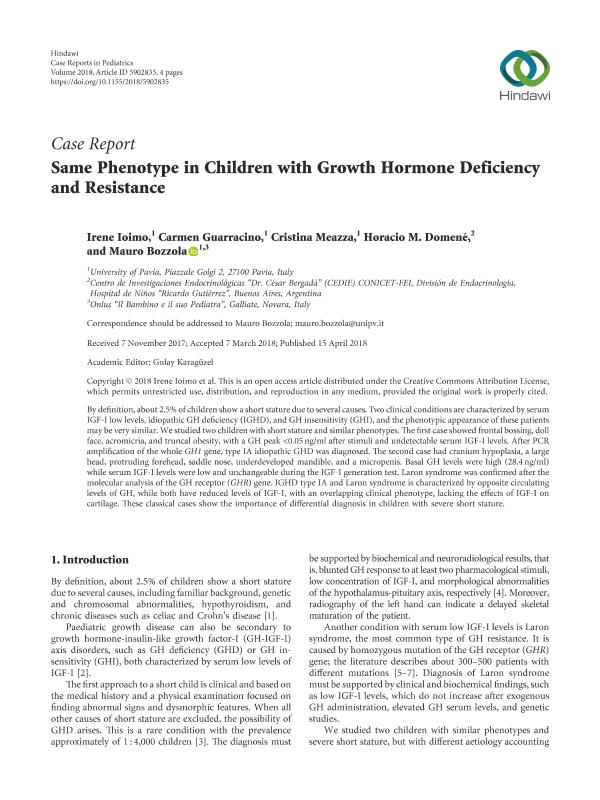Mostrar el registro sencillo del ítem
dc.contributor.author
Ioimo, Irene
dc.contributor.author
Guarracino, Carmen
dc.contributor.author
Meazza, Cristina
dc.contributor.author
Domene, Horacio Mario

dc.contributor.author
Bozzola, Mauro
dc.date.available
2019-10-23T20:17:32Z
dc.date.issued
2018-04
dc.identifier.citation
Ioimo, Irene; Guarracino, Carmen; Meazza, Cristina; Domene, Horacio Mario; Bozzola, Mauro; Same Phenotype in Children with Growth Hormone Deficiency and Resistance; Hindawi Publishing Corporation; Case Reports in Pediatrics; 2018; 4-2018; 1-4; 5902835
dc.identifier.issn
2090-6803
dc.identifier.uri
http://hdl.handle.net/11336/87167
dc.description.abstract
By definition, about 2.5% of children show a short stature due to several causes. Two clinical conditions are characterized by serum IGF-I low levels, idiopathic GH deficiency (IGHD), and GH insensitivity (GHI), and the phenotypic appearance of these patients may be very similar. We studied two children with short stature and similar phenotypes. *e first case showed frontal bossing, dollface, acromicria, and truncal obesity, with a GH peak <0.05 ng/ml after stimuli and undetectable serum IGF-I levels. After PCR amplification of the whole GH1 gene, type IA idiopathic GHD was diagnosed. *e second case had cranium hypoplasia, a large head, protruding forehead, saddle nose, underdeveloped mandible, and a micropenis. Basal GH levels were high (28.4 ng/ml) while serum IGF-I levels were low and unchangeable during the IGF-I generation test. Laron syndrome was confirmed after the molecular analysis of the GH receptor (GHR) gene. IGHD type IA and Laron syndrome is characterized by opposite circulatinglevels of GH, while both have reduced levels of IGF-I, with an overlapping clinical phenotype, lacking the effects of IGF-I on cartilage. *ese classical cases show the importance of differential diagnosis in children with severe short stature.
dc.format
application/pdf
dc.language.iso
eng
dc.publisher
Hindawi Publishing Corporation

dc.rights
info:eu-repo/semantics/openAccess
dc.rights.uri
https://creativecommons.org/licenses/by-nc-sa/2.5/ar/
dc.subject
GROWTH HORMONE DEFICIENCY
dc.subject
TYPE IA
dc.subject
GROWTH HORMONE RESISTANCE
dc.subject
PHENOTYPES
dc.subject.classification
Endocrinología y Metabolismo

dc.subject.classification
Medicina Clínica

dc.subject.classification
CIENCIAS MÉDICAS Y DE LA SALUD

dc.title
Same Phenotype in Children with Growth Hormone Deficiency and Resistance
dc.type
info:eu-repo/semantics/article
dc.type
info:ar-repo/semantics/artículo
dc.type
info:eu-repo/semantics/publishedVersion
dc.date.updated
2019-10-16T15:09:32Z
dc.identifier.eissn
2090-6811
dc.journal.volume
2018
dc.journal.pagination
1-4; 5902835
dc.journal.pais
Egipto

dc.journal.ciudad
El Cairo
dc.description.fil
Fil: Ioimo, Irene. University of Pavia; Italia
dc.description.fil
Fil: Guarracino, Carmen. University of Pavia; Italia
dc.description.fil
Fil: Meazza, Cristina. University of Pavia; Italia
dc.description.fil
Fil: Domene, Horacio Mario. Consejo Nacional de Investigaciones Científicas y Técnicas. Oficina de Coordinación Administrativa Parque Centenario. Centro de Investigaciones Endocrinológicas "Dr. César Bergada". Gobierno de la Ciudad de Buenos Aires. Centro de Investigaciones Endocrinológicas "Dr. César Bergada". Fundación de Endocrinología Infantil. Centro de Investigaciones Endocrinológicas "Dr. César Bergada"; Argentina
dc.description.fil
Fil: Bozzola, Mauro. University of Pavia; Italia
dc.journal.title
Case Reports in Pediatrics
dc.relation.alternativeid
info:eu-repo/semantics/altIdentifier/url/https://www.hindawi.com/journals/cripe/2018/5902835/
dc.relation.alternativeid
info:eu-repo/semantics/altIdentifier/doi/http://dx.doi.org/10.1155/2018/5902835
Archivos asociados
